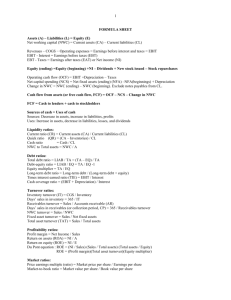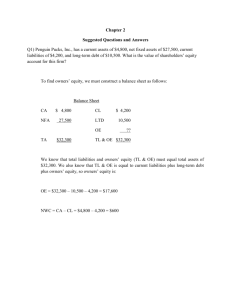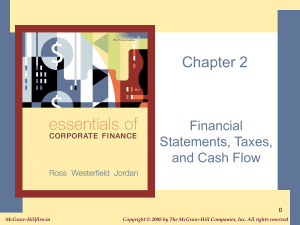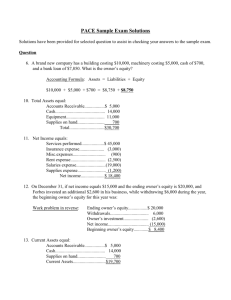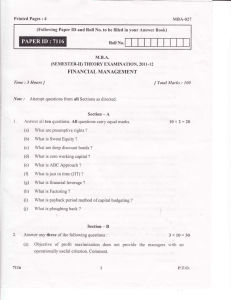RW7eCh02
advertisement
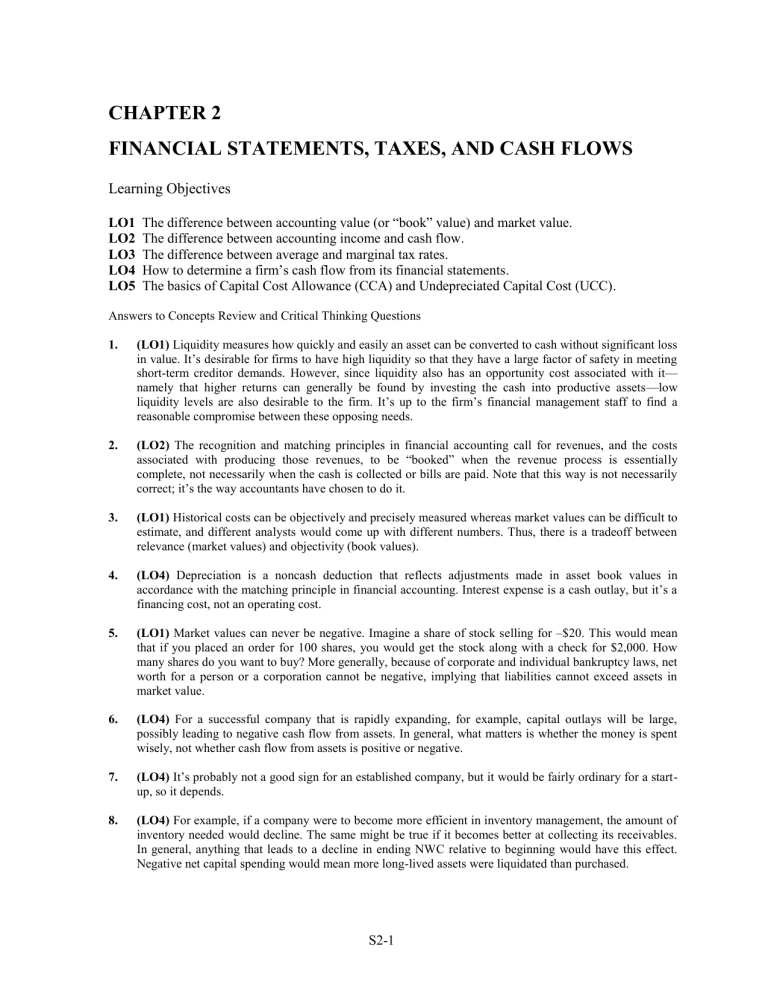
CHAPTER 2 FINANCIAL STATEMENTS, TAXES, AND CASH FLOWS Learning Objectives LO1 LO2 LO3 LO4 LO5 The difference between accounting value (or “book” value) and market value. The difference between accounting income and cash flow. The difference between average and marginal tax rates. How to determine a firm’s cash flow from its financial statements. The basics of Capital Cost Allowance (CCA) and Undepreciated Capital Cost (UCC). Answers to Concepts Review and Critical Thinking Questions 1. (LO1) Liquidity measures how quickly and easily an asset can be converted to cash without significant loss in value. It’s desirable for firms to have high liquidity so that they have a large factor of safety in meeting short-term creditor demands. However, since liquidity also has an opportunity cost associated with it— namely that higher returns can generally be found by investing the cash into productive assets—low liquidity levels are also desirable to the firm. It’s up to the firm’s financial management staff to find a reasonable compromise between these opposing needs. 2. (LO2) The recognition and matching principles in financial accounting call for revenues, and the costs associated with producing those revenues, to be “booked” when the revenue process is essentially complete, not necessarily when the cash is collected or bills are paid. Note that this way is not necessarily correct; it’s the way accountants have chosen to do it. 3. (LO1) Historical costs can be objectively and precisely measured whereas market values can be difficult to estimate, and different analysts would come up with different numbers. Thus, there is a tradeoff between relevance (market values) and objectivity (book values). 4. (LO4) Depreciation is a noncash deduction that reflects adjustments made in asset book values in accordance with the matching principle in financial accounting. Interest expense is a cash outlay, but it’s a financing cost, not an operating cost. 5. (LO1) Market values can never be negative. Imagine a share of stock selling for –$20. This would mean that if you placed an order for 100 shares, you would get the stock along with a check for $2,000. How many shares do you want to buy? More generally, because of corporate and individual bankruptcy laws, net worth for a person or a corporation cannot be negative, implying that liabilities cannot exceed assets in market value. 6. (LO4) For a successful company that is rapidly expanding, for example, capital outlays will be large, possibly leading to negative cash flow from assets. In general, what matters is whether the money is spent wisely, not whether cash flow from assets is positive or negative. 7. (LO4) It’s probably not a good sign for an established company, but it would be fairly ordinary for a startup, so it depends. 8. (LO4) For example, if a company were to become more efficient in inventory management, the amount of inventory needed would decline. The same might be true if it becomes better at collecting its receivables. In general, anything that leads to a decline in ending NWC relative to beginning would have this effect. Negative net capital spending would mean more long-lived assets were liquidated than purchased. S2-1 9. (LO4) If a company raises more money from selling stock than it pays in dividends in a particular period, its cash flow to stockholders will be negative. If a company borrows more than it pays in interest, its cash flow to creditors will be negative. 10. (LO1) Enterprise value is the theoretical takeover price. In the event of a takeover, an acquirer would have to take on the company's debt, but would pocket its cash. Enterprise value differs significantly from simple market capitalization in several ways, and it may be a more accurate representation of a firm's value. In a takeover, the value of a firm's debt would need to be paid by the buyer when taking over a company. This enterprise value provides a much more accurate takeover valuation because it includes debt in its value calculation. Solutions to Questions and Problems Basic 1. (LO1) To find owner’s equity, we must construct a balance sheet as follows: CA NFA TA $4,000 22,500 $26,500 Balance Sheet CL LTD OE TL & OE $3,400 6,800 ?? $26,500 We know that total liabilities and owner’s equity (TL & OE) must equal total assets of $26,500. We also know that TL & OE is equal to current liabilities plus long-term debt plus owner’s equity, so owner’s equity is: OE = $26,500 – 6,800 – 3,400 = $16,300 NWC = CA – CL = $4,000 – 3,400 = $600 2. (LO1) The income statement for the company is: Income Statement Sales $634,000 Costs 305,000 Depreciation 46,000 EBIT $283,000 Interest 29,000 EBT $254,000 Taxes (35%) 88,900 Net income $165,100 3. (LO1) One equation for net income is: Net income = Dividends + Addition to retained earnings Rearranging, we get: Addition to retained earnings = Net income – Dividends = $165,100 – 86,000 = $79,100 4. (LO1) EPS = Net income / Shares DPS = Dividends / Shares = $165,100 / 30,000 = $86,000 / 30,000 S2-2 = $5.50 per share = $2.87 per share 5. (LO1) NWC = CA – CL; CA = $410K + 1.3M = $1.7M Book value CA = $1.7M Market value CA = $1.8M Book value NFA = $2.6M Market value NFA = $3.7M Book value assets= $1.7M + 2.6M = $4.3M Market value assets = $1.8M + 3.7M = $5.5M 6. (LO3) Tax bill = 0.165 x $325,000 = $53,625 7. (LO3) The average tax rate is the total tax paid divided by net income, so: Average tax rate = $53,625 / $325,000 = 16.5% The marginal tax rate is the tax rate on the next $1 of earnings, so again the marginal tax rate = 16.5% because corporations in Canada have a single tax bracket (whereas individuals are subject to progressive taxes in several tax brackets). 8. (LO4) To calculate OCF, we first need the income statement: Income Statement Sales Costs Depreciation EBIT Interest Taxable income Taxes (35%) Net income $14,200 5,600 1,200 $7,400 680 $6,720 2,352 $4,368 OCF = EBIT + Depreciation – Taxes = $7,400 + 1,200 – 2,352 = $6,248 9. (LO4) Net capital spending = NFAend – NFAbeg + Depreciation = $5.2M – 4.6M + 875K = $1.475M 10. (LO4) Change in NWC = NWCend – NWCbeg Change in NWC = (CAend – CLend) – (CAbeg – CLbeg) Change in NWC = ($1,650 – 920) – ($1,400 – 870) Change in NWC = $730 – 530 = $200 11. (LO4) Cash flow to creditors = Interest paid – Net new borrowing = $340K – (LTDend – LTDbeg) Cash flow to creditors = $280K – ($3.3M – 3.1M) = $280K – 200K = $80K 12. (LO4) Cash flow to shareholders = Dividends paid – Net new equity Cash flow to shareholders = $600K – [(Commonend + AREend) – (Commonbeg + AREbeg)] Cash flow to shareholders = $600K – [($885K + 7.7M) – ($860K + 6.9M)] Cash flow to shareholders = $600K – [$8.585M – 7.76M] = –$225K Note, ARE is the additional retained earnings. S2-3 Intermediate 13. (LO4) Cash flow from assets Cash flow from assets Operating cash flow 14. = Cash flow to creditors + Cash flow to shareholders = $80K – 225K = –$145K = –$145K = OCF – Change in NWC – Net capital spending = –$145K = OCF – (–$165K) – 760K = –$145K – 165K + 760K = $450K (LO4) To find the OCF, we first calculate net income. Income Statement Sales $162,000 Costs 93,000 Depreciation 8,400 Other expenses 5,100 EBIT $55,500 Interest 16,500 Taxable income $39,000 Taxes (38%) 14,820 Net income $24,180 Dividends Additions to RE $9,400 $14,780 a. OCF = EBIT + Depreciation – Taxes = $55,500 + 8,400 – 14,820 = $49,080 b. CFC = Interest – Net new LTD = $16,500 – (–6,400) = $22,900 Note that the net new long-term debt is negative because the company repaid part of its longterm debt. c. CFS = Dividends – Net new equity = $9,400 – 7,350 = $2,050 d. We know that CFA = CFC + CFS, so: CFA = $22,900 + 2,050 = $24,950 CFA is also equal to OCF – Net capital spending – Change in NWC. We already know OCF. Net capital spending is equal to: Net capital spending = Increase in NFA + Depreciation = $12,000 + 8,400 = $20,400 Now we can use: CFA = OCF – Net capital spending – Change in NWC $24,950 = $49,080 – 20,400 – Change in NWC Solving for the change in NWC gives $3,730, meaning the company increased its NWC by $3,730. S2-4 15. (LO1) The solution to this question works the income statement backwards. Starting at the bottom: Net income = Dividends + Addition to ret. earnings = $1,200 + 4,300 = $5,500 Now, looking at the income statement: EBT – EBT × Tax rate = Net income Recognize that EBT × tax rate is simply the calculation for taxes. Solving this for EBT yields: EBT = NI / (1– tax rate) = $5,500 / (1 – 0.35) = $8,462 Now you can calculate: EBIT = EBT + Interest = $8,462 + 2,300 = $10,762 The last step is to use: EBIT = Sales – Costs – Depreciation EBIT = $34,000 – 16,000 – Depreciation = $10,762 Solving for depreciation, we find that depreciation = $7,238 16. (LO1) The balance sheet for the company looks like this: Cash Accounts receivable Inventory Current assets Tangible net fixed assets Intangible net fixed assets Total assets Balance Sheet $210,000 Accounts payable 149,000 Notes payable 265,000 Current liabilities $624,000 Long-term debt Total liabilities 2,900,000 720,000 Common stock Accumulated ret. earnings $4,244,000 Total liab. & owners’ equity $430,000 180,000 $610,000 1,430,000 $2,040,000 ?? 1,865,000 $4,244,000 Total liabilities and owners’ equity is: TL & OE = CL + LTD + Common stock + Retained earnings Solving for this equation for equity gives us: Common stock = $4,244,000 – 1,865,000 – 2,040,000 = $339,000 17. (LO1) The market value of shareholders’ equity cannot be zero. A negative market value in this case would imply that the company would pay you to own the stock. The market value of shareholders’ equity can be stated as: Shareholders’ equity = Max [(TA – TL), 0]. So, if TA is $6,700, equity is equal to $600, and if TA is $5,900, equity is equal to $0. We should note here that the book value of shareholders’ equity can be negative. S2-5 18. (LO3) a. Taxes Growth Taxes Income = 0.165($82,000) = $13,530 = 0.330($8,200,000) = $2,706,000 b. The firms have different marginal tax rates. Corporation Growth pays an additional $1,650 of taxes and in general pays 16.5% of its next dollar of taxable income in taxes. Corporation Income pays $3,300 of taxes and in general pays 33.0% of its next dollar of taxable income in taxes. 19. (LO2) Income Statement Sales $840,000 COGS 625,000 A&S expenses 120,000 Depreciation 130,000 EBIT –$35,000 Interest 85,000 Taxable income –$120,000 Taxes (35%) 0 Net income –$120,000 a. 20. b. OCF = EBIT + Depreciation – Taxes = –$35,000 + 130,000 – 0 = $95,000 c. Net income was negative because of the tax deductibility of depreciation and interest expense. However, the actual cash flow from operations was positive because depreciation is a non-cash expense and interest is a financing expense, not an operating expense. (LO4) A firm can still pay out dividends if net income is negative; it just has to be sure there is sufficient cash flow to make the dividend payments. Change in NWC = Net capital spending = Net new equity = 0. (Given) Cash flow from assets = OCF – Change in NWC – Net capital spending Cash flow from assets = $95K – 0 – 0 = $95K Cash flow to shareholders = Dividends – Net new equity = $30K – 0 = $30K Cash flow to creditors = Cash flow from assets – Cash flow to shareholders = $95K – 30K = $65K Cash flow to creditors = Interest – Net new LTD Net new LTD = Interest – Cash flow to creditors = $85K – 65K = $20K 21. (LO2) a. Income Statement Sales Cost of goods sold Depreciation EBIT Interest Taxable income Taxes (34%) Net income b. $15,200 11,400 2,700 $ 1,100 520 $ 580 197 $ 383 OCF = EBIT + Depreciation – Taxes = $1,100 + 2,700 – 197 = $3,603 S2-6 c. Change in NWC = NWCend – NWCbeg = (CAend – CLend) – (CAbeg – CLbeg) = ($3,850 – 2,100) – ($3,200 – 1,800) = $1,750 – 1,400 = $350 Net capital spending CFA = NFAend – NFAbeg + Depreciation = $9,700 – 9,100 + 2,700 = $3,300 = OCF – Change in NWC – Net capital spending = $3,603 – 350 – 3,300 = –$47 The cash flow from assets can be positive or negative, since it represents whether the firm raised funds or distributed funds on a net basis. In this problem, even though net income and OCF are positive, the firm invested heavily in both fixed assets and net working capital; it had to raise a net $47 in funds from its shareholders and creditors to make these investments. d. Cash flow to creditors Cash flow to shareholders = Interest – Net new LTD = $520 – 0 = $520 = Cash flow from assets – Cash flow to creditors = –$47 – 520 = –$567 We can also calculate the cash flow to shareholders as: Cash flow to shareholders = Dividends – Net new equity Solving for net new equity, we get: Net new equity = $600 – (–567) = $1,167 The firm had positive earnings in an accounting sense (NI > 0) and had positive cash flow from operations. The firm invested $350 in new net working capital and $3,300 in new fixed assets. The firm had to raise $47 from its stakeholders to support this new investment. It accomplished this by raising $1,167 in the form of new equity. After paying out $600 of this in the form of dividends to shareholders and $520 in the form of interest to creditors, $47 was left to meet the firm’s cash flow needs for investment. 22. (LO4) a. Total assets 2008 Total liabilities 2008 Owners’ equity 2008 = $725 + 2,990 = $3,715 = $290 + 1,580 = $1,870 = $3,715 – 1,870 = $1,845 Total assets 2009 Total liabilities 2009 Owners’ equity 2009 = $785 + 3,600 = $4,385 = $325 + 1,680 = $2,005 = $4,385 – 2,005 = $2,380 b. NWC 2008 NWC 2009 Change in NWC = CA08 – CL08 = $725 – 290 = $435 = CA09 – CL09 = $785 – 325 = $460 = NWC09 – NWC08 = $460 – 435 = $25 S2-7 c. We can calculate net capital spending as: Net capital spending Net capital spending = Net fixed assets 2009 – Net fixed assets 2008 + Depreciation = $3,600 – 2,990 + 820 = $1,430 So, the company had a net capital spending cash flow of $1,430. We also know that net capital spending is: Net capital spending $1,430 Fixed assets sold = Fixed assets bought – Fixed assets sold = $1,500 – Fixed assets sold = $1,500 – 1,430 = $70 To calculate the cash flow from assets, we must first calculate the operating cash flow. The operating cash flow is calculated as follows (you can also prepare a traditional income statement): d. 23. EBIT EBT Taxes OCF Cash flow from assets = Sales – Costs – Depreciation = $9,200 – 4,290 – 820 = $4,090 = EBIT – Interest = $4,090 – 234 = $3,856 = EBT .35 = $3,856 .35 = $1,350 = EBIT + Depreciation – Taxes = $4,090 + 820 – 1,350 = $3,560 = OCF – Change in NWC – Net capital spending. = $3,560 – 25 – 1,430 = $2,105 Net new borrowing Cash flow to creditors Net new borrowing Debt retired = LTD09 – LTD08 = $1,680 – 1,580 = $100 = Interest – Net new LTD = $234 – 100 = $134 = $100 = Debt issued – Debt retired = $300 – 100 = $200 (LO3) Based on information given, the full net income generated amounting to $700,000 is available for distribution to investors. To determine the net after-tax receipt by investors: Income $700,000 Corporate income tax 0 Amount distributed to investor 700,000 Amount included in income 700,000 Personal income tax (44%) 308,000 Investor’s net receipt $392,000 24. (LO3) Compare the investor’s net receipt if dividends are paid versus what would be received from an income trust distribution: Dividends Income $500,000 Corporate income tax (35%) 175,000 Amount distributed 325,000 Tax on dividends (23%) 74,750 Tax on interest income (48%) Investors’ net receipt $250,250 Income trust distributions $500,000 0 500,000 240,000 $260,000 It appears that investors would benefit from the conversion. For each unit held upon conversion, an investor would gain ($260,000 - $250,250)/10,000 = $0.975. For an investor holding 2,000 units the gain would be = 2,000 ($0.975) = $1,950. S2-8 Challenge 25. 26. (LO4) Net capital spending = NFAend – NFAbeg + Depreciation = (NFAend – NFAbeg) + (Depreciation + ADbeg) – ADbeg = (NFAend – NFAbeg)+ ADend – ADbeg = (NFAend + ADend) – (NFAbeg + ADbeg) = FAend – FAbeg (LO1) Cash Accounts receivable Inventory Current assets Net fixed assets Total assets Cash Accounts receivable Inventory Current assets Net fixed assets Total assets Balance sheet as of Dec. 31, 2008 $2,528 Accounts payable 3,347 Notes payable 5,951 Current liabilities $11,826 Long-term debt $21,203 Owners' equity $33,029 Total liab. & equity Balance sheet as of Dec. 31, 2009 $2,694 Accounts payable 3,928 Notes payable 6,370 Current liabilities $12,992 Long-term debt $2,244 Owners' equity $15,236 Total liab. & equity $2,656 488 $3,144 $8,467 21,418 $33,029 $2,683 478 $3,161 $10,290 1,785 $15,236 2008 Income Statement Sales $4,822.00 COGS 1,668.00 Other expenses 394.00 Depreciation 692.00 EBIT $2,068.00 Interest 323.00 EBT $1,745.00 Taxes (40%) 698.00 Net income $1,047.00 2009 Income Statement Sales $5,390.00 COGS 1,901.00 Other expenses 343.00 Depreciation 723.00 EBIT $2,423.00 Interest 386.00 EBT $2,037.00 Taxes (40%) 814.80 Net income $1,222.20 Dividends Additions to RE Dividends Additions to RE $588.00 459.00 S2-9 $674.00 548.20 27. (LO4) OCF = EBIT + Depreciation – Taxes = $2,423 + 723 – 814.80 = $2,331.20 Change in NWC = NWCend – NWCbeg = (CA – CL) end – (CA – CL) beg = ($12,992 – 3,161) – ($11,826 – 3,144) = $1,149 = NFAend – NFAbeg + Depreciation = $2,244 – 21,203 + 723 = –$18,236 Net capital spending Cash flow from assets = OCF – Change in NWC – Net capital spending = $2,331.20 – 1,149 – (–18,236) = 19,418.20 Cash flow to creditors = Interest – Net new LTD Net new LTD = LTDend – LTDbeg Cash flow to creditors = $386 – ($10,290 – 8,467) = –$1,437 Net new equity = Common stockend – Common stockbeg Common stock + Retained earnings = Total owners’ equity Net new equity = (OE – RE) end – (OE – RE) beg = OEend – OEbeg + REbeg – REend REend = REbeg + Additions to RE04 Net new equity = OEend – OEbeg + REbeg – (REbeg + Additions to RE0) = OEend – OEbeg – Additions to RE Net new equity = $1,785 – 21,418 – 548.20 = –$20,181.20 CFS CFS = Dividends – Net new equity = $674 – (–20,181.20) = $20,855.20 As a check, cash flow from assets is $19,418.20 CFA CFA 28. = Cash flow from creditors + Cash flow to shareholders = –$1,437 +20,855.20 = $19,418.20 (LO3) DIVIDENDS Dividend Gross up (45%) Federal Tax (29%) Div. Tax Cr. (18.98%) Net Federal Tax Prov. Tax (10%) Div. Tax Cr. (7.40%) Net Provincial Tax Tax Payable INTEREST $40,000 18,000 58,000 16,820 -11,008 $5,812 5,800 -4,292 $1,508 $7,320 Interest Federal Tax (29%) Prov. Tax (10%) Tax Payable $20,000 5,800 2,000 $7,800 CAPITAL GAINS Capital Gain Fed. Tax (1/2 x 29%) Prov. Tax (1/2 x10%) Tax Payable $20,000 2,900 1,000 $3,900 Cash Flow from Dividends = $40,000 - $7,320 = $32,680 Cash Flow from Interest = $20,000 - $7,800 = $12,200 Cash Flow from Capital Gains = $20, 000 - $3,900 = $16,100 Note: A provincial dividend tax credit of 7.40% is assumed. The actual dividend tax rate for an Alberta resident should be verified. S2-10 29. 30. 31. (LO3) a. After Tax Rate of Return on Dividends b. After Tax Rate of Return on Interest c. After Tax Rate of Return on Capital Gains (LO5) Year 1 2 3 4 5 (LO5) Year 1 2 3 4 5 = $32,680/$75,000 = 43.57% = $12,200/$75,000 = 16.27% = $16,100/$75,000 = 21.47% Beginning UCC 25% CCA Ending UCC $250,000* $62,500 $187,500 $437,500 $109,375 $328,125 $328,125 $82,031.25 $246,093.75 $246,093.75 $61,523.44 $184,570.31 $184,570.31 $46,142.78 $138,427.53 *50% of $500,000 to incorporate the half-year rule. Beginning UCC $500,000* $900,000 $720,000 $576,000 $460,800 20% CCA $100,000 $180,000 $144,000 $115,200 $92,160 Ending UCC $400,000 $720,000 $576,000 $460,800 $368,640 *50% of $1,000,000 to incorporate the half-year rule. 32. (LO5) Year 1 2 3 4 5 Beginning UCC $50000* $85,000 $59,500 $41,650 $29,155 30% CCA $15,000 $25,500 $17,850 $12,495 $ 8,746.5 Ending UCC $35,000 $59,500 $41,650 $29,155 $ 408.50** *50% of $100,000 to incorporate the half-year rule **($29,155)(0.7) – (0.2) ($100,000) = $408.50 If the asset class is continued, there will be no tax consequences - the after-tax proceeds from the sale will be $100,000 x .20 = $20,000. 33. (LO5) Year 2008 2009 CCA on equipment Beginning UCC 20% CCA $2,100,000* $420,000 $3,780,000 $756,000 Ending UCC $1,680,000 $3,024,000 *50% of $4,200,000 (includes the installation cost) to incorporate the half-year rule Year 2008 2009 CCA on building Beginning UCC 5% CCA $2,000,000* $100,000 $3,900,000 $195,000 *50% of $4,000,000 CCA for 2008 = $420,000 + $100,000 = $520,000 CCA for 2009 = $756,000 + $195,000 = $951,000 S2-11 Ending UCC $1,900,000 $3,705,000 34. (LO5) Year 2005 2006 2007 2008 2009 Beginning UCC $ 170,000* $ 255,000 $ 127,500 $ 668,750** $1,084,375 50% CCA $ 85,000 $127,500 $ 63,750 $334,375 $542,187.5 Ending UCC $ 85,000 $127,500 $ 63,750 $334,375 $542,187.5 *50% of $340,000 **UCC2008 = 0.5 ($1,500,000) – 145,000 + $63,750 = $668,750 35. (LO3) a. Federal tax = 0.29($57,000)(0.05) = $826.50 Provincial tax = 0.10($57,000)(0.05) = $285.00 After tax income = $2,850 – $826.50 – $285.00 = $1,738.50 b. Federal tax on dividends = 1.45($25)(250)(0.29 – 0.1898) = $908.06 (rounded) Provincial tax on dividends = 1.45($25)(250)(0.10 – 0.0740) = $235.63 (rounded) After tax income = $25(250) – $908.06 – $235.63 = $5,106.31 Assumes a provincial dividend tax credit of 7.40%. The actual dividend tax credit for an Alberta resident should be verified. c. Federal tax on capital gain = $15(500)(0.5)(0.29) = $1,087.50 Provincial tax on capital gain = $15(500)(0.5)(0.10) = $375 After tax income = $7,500 – $1,087.50 – $375 = $6,037.50 36. (LO3) Carry the ($600) loss in 2006 back 3 years and the remaining loss is carried forward 7 years: (in 1,000's) total carry backs = $116 + $140 + $168 = $424 leaving ($600 – $424) to carry forward which effectively reduces taxable income to zero for all years through 2009. At that time, remaining carryforward is $56. 37. (LO5) a. UCC0=99,200(1/2) = 49,600 CCA1=14,880 UCC1=84,320 UCC5=84,320(1-.30)4 = $20,245.23 b. Since the asset has no value and the asset pool remains open, there are no tax consequences. S2-12
